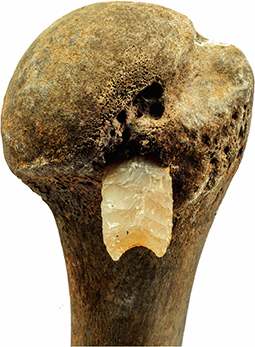Nancy Szokan
Source - https://www.washingtonpost.com/national/health-science/dig-reveals-an-event-so-violent-that-its-participants-must-have-been-civilized/2016/03/31/64cc6968-f6ba-11e5-9804-537defcc3cf6_story.html?
In 1996, an amateur archaeologist found a human arm bone sticking out of a steep bank of the Tollense River in northern Germany. Firmly embedded in one end was a flint arrowhead.
 The flint arrowhead embedded in this upper arm bone first alerted archaeologists to the long-ago violence in the Tollense Valley. PHOTO: LANDESAMT FÜR KULTUR UND DENKMALPFLEGE MECKLENBURG-VORPOMMERN/LANDESARCHÄOLOGIE/S. SUHR
The flint arrowhead embedded in this upper arm bone first alerted archaeologists to the long-ago violence in the Tollense Valley. PHOTO: LANDESAMT FÜR KULTUR UND DENKMALPFLEGE MECKLENBURG-VORPOMMERN/LANDESARCHÄOLOGIE/S. SUHR
A test excavation revealed more bones, a smashed skull and a club that looked like a baseball bat. Radiocarbon dating indicated they came from a single episode around 1250 B.C. — in other words, some kind of fight.
The discovery set off intense interest in the archaeological community, Andrew Curry writes in the journal Science. A series of excavations between 2009 and 2015 revealed carnage on a scale no one had expected: 10,000 bones, including those identifiable as coming from five horses and 130 men.
Because the researchers have thus far excavated less than 10 percent of what they call the “find layer” — archaeology is slow work — one of them speculates that they will eventually find 750 dead men. If 1 in 5 of the warriors were killed and left on the battlefield, they are seeing evidence of a battle involving almost 4,000 fighters.
That would be a battle “of a scale hitherto completely unknown north of the Alps” in that era, archaeologist Thomas Terberger told Curry. “There’s nothing to compare it to.”
Sophisticated techniques have enabled scientists to piece together a picture of the event: Geomagnetic imagery indicates it took place around a 120-yard-long bridge. Isotopes in the victims’ teeth, which reflect food and water ingested in childhood, suggest that many of the warriors had been born hundreds of miles away.
Evidence of wounds that had healed years before imply that these were professional soldiers, not primitive farmers caught up in a single squabble. Standardized metal weapons show organization, as does the sheer size of the combatant forces.
Ironically, the huge scale of the conflict is seen as evidence that civilization in northern Europe was much more advanced than previously thought. The area has long been seen as a backwater, nothing like the developed civilizations of the Bronze Age in the Middle East or Asia.
But the scene on the Tollense River suggests an unexpectedly widespread social structure: “To organize a battle like this over tremendous distances and gather all these people in one place was a tremendous accomplishment,” archaeologist Detlef Jantzen says.